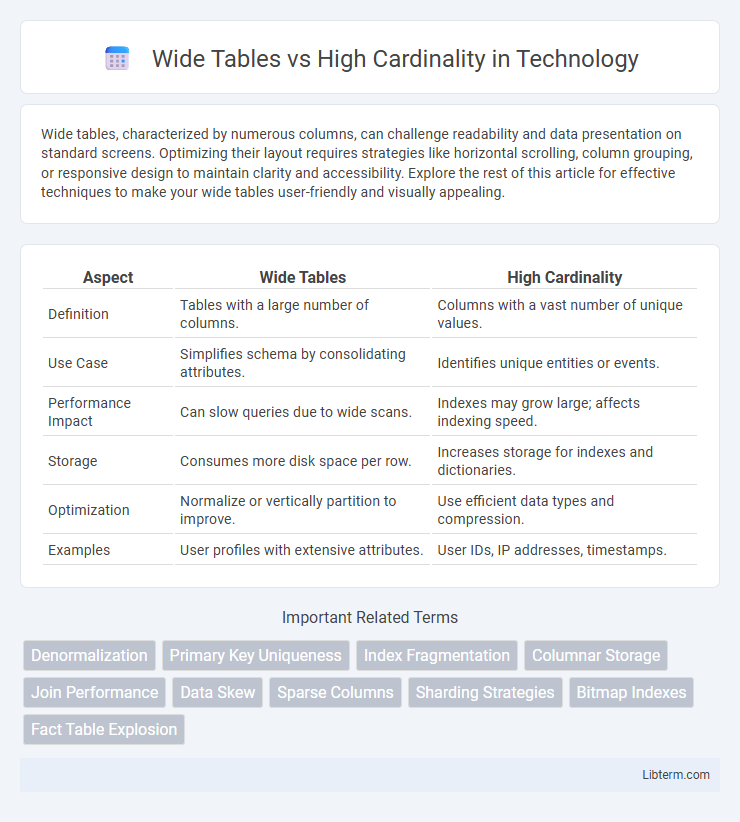Wide tables, characterized by numerous columns, can challenge readability and data presentation on standard screens. Optimizing their layout requires strategies like horizontal scrolling, column grouping, or responsive design to maintain clarity and accessibility. Explore the rest of this article for effective techniques to make your wide tables user-friendly and visually appealing.
Table of Comparison
| Aspect | Wide Tables | High Cardinality |
|---|---|---|
| Definition | Tables with a large number of columns. | Columns with a vast number of unique values. |
| Use Case | Simplifies schema by consolidating attributes. | Identifies unique entities or events. |
| Performance Impact | Can slow queries due to wide scans. | Indexes may grow large; affects indexing speed. |
| Storage | Consumes more disk space per row. | Increases storage for indexes and dictionaries. |
| Optimization | Normalize or vertically partition to improve. | Use efficient data types and compression. |
| Examples | User profiles with extensive attributes. | User IDs, IP addresses, timestamps. |
Understanding Wide Tables in Data Management
Wide tables in data management contain a large number of columns, often designed to store diverse attributes within a single database record, which can optimize query performance for specific use cases. Managing wide tables requires careful schema design to handle potential sparsity and ensure efficient storage and retrieval, particularly in columnar databases or data warehouses. Understanding the balance between wide tables and high cardinality helps maintain scalability and query efficiency in complex datasets.
Defining High Cardinality: What It Means
High cardinality refers to columns in a database that contain a large number of unique values, such as user IDs or email addresses, which can impact indexing performance and query efficiency. Unlike wide tables that simply have many columns, high cardinality focuses on the distinctiveness and distribution of data within individual columns. Understanding high cardinality is crucial for designing optimized database schemas and improving search and retrieval operations.
Key Differences Between Wide Tables and High Cardinality
Wide tables contain a large number of columns, often to store diverse attributes, whereas high cardinality refers to columns with many unique values, impacting indexing and query performance differently. Wide tables can lead to sparse data and increased I/O, while high cardinality challenges indexing strategies and query optimization, particularly in databases like SQL or NoSQL systems. Understanding wide tables focuses on schema design, whereas high cardinality centers on data distribution within specific columns.
Use Cases for Wide Tables
Wide tables, characterized by a large number of columns, are ideal for use cases such as customer profiles in CRM systems, where storing extensive attributes per entity is necessary. They enable efficient querying and analysis of diverse data points related to a single record without the overhead of multiple joins. Industries like healthcare and finance benefit significantly from wide tables to capture complex, multi-dimensional datasets within a unified table structure.
Scenarios Favoring High Cardinality
High cardinality excels in scenarios requiring detailed, unique identification such as user IDs, transaction codes, or sensor data streams where distinct values enable precise filtering and analysis. Its effectiveness is evident in fraud detection systems, recommendation engines, and personalization algorithms that rely on granular data differentiation. High cardinality supports complex queries on extensive datasets by leveraging indexing and compression techniques to maintain performance.
Performance Implications: Wide Tables vs High Cardinality
Wide tables with numerous columns can degrade query performance by increasing I/O operations and memory usage during data retrieval. High cardinality, characterized by many unique values in a column, impacts indexing efficiency and slows aggregation and join operations. Balancing table width and cardinality is crucial to optimize database performance, as excessively wide tables or high cardinality columns can lead to slower query execution and increased resource consumption.
Storage Considerations and Data Scalability
Wide tables, characterized by numerous columns, often require significant storage space due to increased metadata and sparse data representation, impacting disk I/O efficiency. High cardinality, involving columns with a vast number of unique values, leads to larger index sizes and challenges in compression, affecting query performance and storage scalability. Balancing wide tables and high cardinality demands optimizing columnar storage formats, efficient indexing strategies, and leveraging partitioning techniques to ensure scalable data warehousing solutions.
Query Optimization Strategies
Wide tables with numerous columns often require careful indexing and column pruning techniques to optimize query performance, preventing excessive I/O operations. High cardinality attributes benefit significantly from bitmap or hash-based indexing, enabling efficient filtering and join operations. Combining partitioning strategies with selective indexing further enhances query execution plans by minimizing data scans and improving predicate pushdown efficiency.
Best Practices for Schema Design
Designing schemas for wide tables with high cardinality requires balancing query performance and storage efficiency. Use vertical partitioning to reduce table width, and apply indexing strategies like bitmap or hash indexes to manage high cardinality columns effectively. Implement data normalization selectively, and leverage columnar storage or database-specific features such as PostgreSQL's partitioning or BigQuery's clustering to optimize access patterns.
Choosing Between Wide Tables and High Cardinality
Choosing between wide tables and high cardinality depends on your data model and query patterns; wide tables can improve query performance by reducing joins but may lead to sparse data and storage inefficiencies. High cardinality attributes, such as unique user IDs or transaction IDs, increase the table's complexity and indexing requirements, potentially impacting query speed and storage optimization. Evaluating the trade-offs involves analyzing data distribution, query frequency, and system limitations to determine the most efficient schema design for scalability and maintainability.
Wide Tables Infographic

 libterm.com
libterm.com